Potential role of P2X7R in esophageal squamous cell carcinoma proliferation
- PMID: 28397110
- PMCID: PMC5563289
- DOI: 10.1007/s11302-017-9559-2
Potential role of P2X7R in esophageal squamous cell carcinoma proliferation
Abstract
Esophageal cancer is an aggressive tumor and is the sixth leading cause of cancer death worldwide. ATP is well known to regulate cancer progression in a variety of models by different mechanisms, including P2X7R activation. This study aimed to evaluate the role of P2X7R in esophageal squamous cell carcinoma (ESCC) proliferation. Our results show that treatment with high ATP concentrations induced a decrease in cell number, cell viability, number of polyclonal colonies, and reduced migration of ESCC. The treatment with the selective P2X7R antagonist A740003 or siRNA for P2X7 reverted this effect in the KYSE450 cell line. In addition, results showed that P2X7R is highly expressed, at mRNA and protein levels, in KYSE450 lineage. Additionally, KYSE450, KYSE30, and OE21 cells express P2X3R, P2X4R, P2X5R, P2X6R, and P2X7R genes. P2X1R is expressed by KYSE30 and KYSE450, and only KYSE450 expresses the P2X2R gene. Furthermore, esophageal cancer cell line KYSE450 presented higher expression of E-NTPDases 1 and 2 and of Ecto-5'-NT/CD73 when compared to normal cells. This cell line also exhibits ATPase, ADPase, and AMPase activity, although in different levels, and the co-treatment of apyrase was able to revert the antiproliferative effects of ATP. Moreover, results showed high immunostaining for P2X7R in biopsies of patients with esophageal carcinoma, indicating the involvement of this receptor in the growth of this type of cancer. The results suggest that P2X7R may be a potential pharmacological target to treat ESCC and can lead us to further investigate the effect of this receptor in cancer cell progression.
Keywords: ATP; Ectonucleotidases; Esophageal cancer; P2X7R; Proliferation.
Conflict of interest statement
Conflicts of interest
André A Santos Jr declares that he has no conflict of interest.
Angélica R Cappellari declares that she has no conflict of interest.
Fernanda O de Marchi declares that she has no conflict of interest.
Marina P Gehring declares that she has no conflict of interest.
Aline Zaparte declares that she has no conflict of interest.
Caroline A Brandão declares that she has no conflict of interest.
Tiago Giuliani Lopes declares that he has no conflict of interest.
Luis Felipe Ribeiro Pinto that he has no conflict of interest.
Vinicius Duval da Silva declares that he has no conflict of interest.
Robson Coutinho-Silva declares that he has no conflict of interest.
Juliano D Paccez declares that she has no conflict of interest.
Luiz F Zerbini declares that he has no conflict of interest.
Fernanda B Morrone declares that she has no conflict of interest.
Ethical approval
Histological samples of human ESCC and esophageal tissue samples of patients with esophagitis were collected, between July and December 2015, from patients who underwent endoscopic procedures with biopsies and/or surgical resection at Pontificia Universidade Católica do Rio Grande do Sul (PUCRS, Porto Alegre, Brazil). The diagnosis was reviewed by two certified pathologists with at least 20-year experience in surgical pathology. Samples were obtained in accordance with approved ethical standards of the Institutional Research Ethics Committee (CAAE 4969 6115.0.0000.5336).
Figures
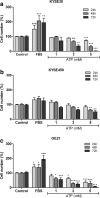
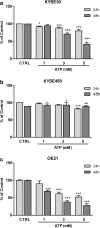


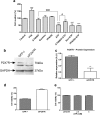
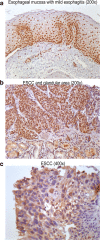
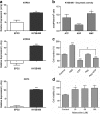
Similar articles
-
Musashi1, a potential prognostic marker in esophageal squamous cell carcinoma.Oncol Rep. 2017 Sep;38(3):1724-1732. doi: 10.3892/or.2017.5809. Epub 2017 Jul 12. Oncol Rep. 2017. PMID: 28713964 Free PMC article.
-
Androgen receptor promotes esophageal cancer cell migration and proliferation via matrix metalloproteinase 2.Tumour Biol. 2015 Aug;36(8):5859-64. doi: 10.1007/s13277-015-3257-x. Epub 2015 Feb 28. Tumour Biol. 2015. PMID: 25724186
-
Knockdown of DDX46 inhibits proliferation and induces apoptosis in esophageal squamous cell carcinoma cells.Oncol Rep. 2016 Jul;36(1):223-30. doi: 10.3892/or.2016.4803. Epub 2016 May 11. Oncol Rep. 2016. PMID: 27176873
-
Roles of purinergic P2X7 receptor in glioma and microglia in brain tumors.Cancer Lett. 2017 Aug 28;402:93-99. doi: 10.1016/j.canlet.2017.05.004. Epub 2017 May 20. Cancer Lett. 2017. PMID: 28536012 Review.
-
Neuronal P2X7 Receptor: Involvement in Neuronal Physiology and Pathology.J Neurosci. 2017 Jul 26;37(30):7063-7072. doi: 10.1523/JNEUROSCI.3104-16.2017. J Neurosci. 2017. PMID: 28747389 Free PMC article. Review.
Cited by
-
Extracellular ATP/P2X7 receptor, a regulatory axis of migration in ovarian carcinoma-derived cells.PLoS One. 2024 Jun 13;19(6):e0304062. doi: 10.1371/journal.pone.0304062. eCollection 2024. PLoS One. 2024. PMID: 38870128 Free PMC article.
-
P2RX7 promotes osteosarcoma progression and glucose metabolism by enhancing c-Myc stabilization.J Transl Med. 2023 Feb 20;21(1):132. doi: 10.1186/s12967-023-03985-z. J Transl Med. 2023. PMID: 36803784 Free PMC article.
-
P2X7 receptor: a critical regulator and potential target for breast cancer.J Mol Med (Berl). 2021 Mar;99(3):349-358. doi: 10.1007/s00109-021-02041-x. Epub 2021 Jan 23. J Mol Med (Berl). 2021. PMID: 33486566 Review.
-
EMP2 induces cytostasis and apoptosis via the TGFβ/SMAD/SP1 axis and recruitment of P2RX7 in urinary bladder urothelial carcinoma.Cell Oncol (Dordr). 2021 Oct;44(5):1133-1150. doi: 10.1007/s13402-021-00624-x. Epub 2021 Aug 2. Cell Oncol (Dordr). 2021. PMID: 34339014
-
P2X7 receptors: a bibliometric review from 2002 to 2023.Purinergic Signal. 2024 Feb 29. doi: 10.1007/s11302-024-09996-9. Online ahead of print. Purinergic Signal. 2024. PMID: 38421486 Review.
References
-
- Zhang Y, Pan T, Zhong X, Cheng C. Nicotine upregulates microRNA-21 and promotes TGF-beta-dependent epithelial-mesenchymal transition of esophageal cancer cells. Tumour Biol. 2014;35(7):7063–7072. - PubMed
-
- Instituto Nacional de Câncer José de Alencar Gomes da Silva (2015) Estimate (2016) - Cancer Incidence in Brazil. Rio de Janeiro, INCA
-
- Morita M, Kumashiro R, Kubo N, Nakashima Y, Yoshida R, Yoshinaga K, Saeki H, Emi Y, KakejiY SY, Toh Y, Maehara Y. Alcohol drinking, cigarette smoking, and the development of squamous cell carcinoma of the esophagus: epidemiology, clinical findings, and prevention. Int J ClinOncol. 2010;15(2):126–134. - PubMed
-
- Verschuur EM, Siersema PD. Diagnostics and treatment of esophageal cancers. NedTijdschrTandheelkd. 2010;117(9):427–431. - PubMed
MeSH terms
Substances
LinkOut - more resources
Full Text Sources
Other Literature Sources
Research Materials
Miscellaneous

